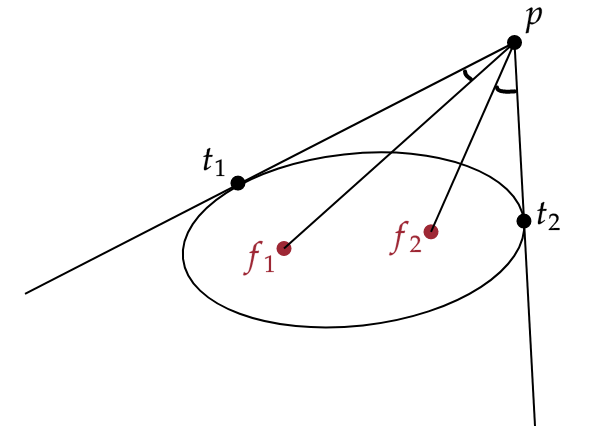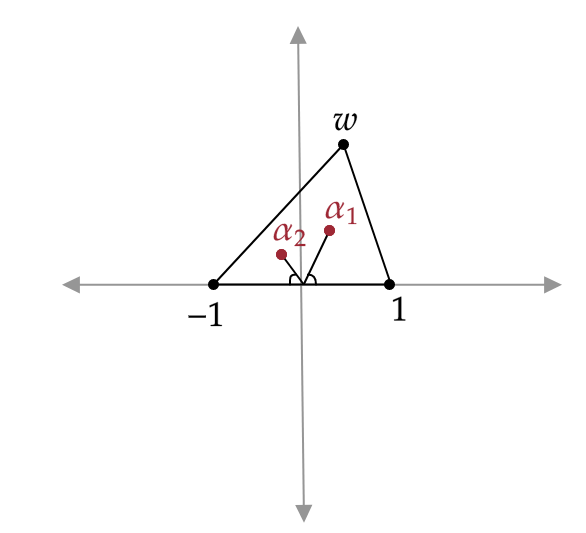The Steiner Inellipse
For simplicity, a polnomial defined on this page is
seperable, i.e., its roots are distinct. Everything still holds true for polynomials whose roots have
multiplicity greater than 1, but sometimes this is annoying to check.
It's easy to see that the root of the derivative of a quadratic is the midpoint of the roots of the quadratic:
Let . Then . So setting , we get
.
But what happens when we have a cubic? Do its two roots follow a similar even distribution? Here I will show a
theorem, due to Marden, showing that the roots of a cubic have a nice geometric property.
Theorem. Let be a cubic polynomial with roots , , and .
Then the roots of
the derivative are exactly the focii of an ellipse which is tangent to the midpoints of the line
segments , , and . This ellipse is known as the Steiner Inellipse.

The proof I'll show here is an adaptation of Dan Kalman's proof,
(which is an amalgamation of proofs by Marden [from 1929] and Bocher [from 1892], although the first proof seems
to be attributed to Siebeck [from 1864]). To begin we'll state a few facts that we'll need. If you're not
convinced of any of these facts, I prove them out of the way; see their adjacent links.
Facts:
- Let be a linear transformation and let .
Define Then if is a root of , is a root
of . In other words, we can transform the initial triangle via any linear
transformation and its roots will follow appropriately. ᐅ
- For a quadratic polynomial with roots and , the
coefficients are
given by and . ᐅ
- Let and be focii of an ellipse, and let be a point outside of the ellipse.
The point
induces (exactly) two tangent lines of the ellipse which intersect ; call the intersection of
these lines with the ellipse . Then . ᐅ

We'll break the proof down into two lemmas...
Lemma 1. Let be the triangle in with vertices , which are the roots of
the monic polynomial . Then if the ellipse with the roots of as the focii passes through
the midpoint of one side of , it is actually tangent to that side of .
Proof. By Fact 1, we can apply some linear transformation such that the vertices of
are -1, 1, and , with . We want to show that the horizontal axis is tangent to the
ellipse. So we have
and thus
So (by Fact 2) if and are the roots of , they satisfy and . In particular, thinking of , we see that the roots lie in the upper half-plane and that . In
other words, as vectors, and are supplementary. So the angles made by the focii and
the point 0 on the ellipse with the -axis are equal. Thus, the horizontal axis is a tangent line of the
ellipse.
This is
what we wanted to show.

Lemma 2. Let be the triangle in with vertices , which are the roots
of
the monic polynomial . If the ellipse with roots of as the focii is tangent to one side of
, then it is tangent to all sides of .
Proof. Again by Fact 1, we can let the vertices of be 0, 1, and for
. Then
Taking the derivative, we get
By similar tactics as in Lemma 1, we see that and .
Note that both and are in the upper half-plane. Let
and . Without loss, say So we get from the equations above
that . In other words . By Fact
3 (with 0 as the point ), we get that the line is a tangent line to the ellipse. We can
reapply this argument to the
third edge (perhaps on a different linear transformation) to get the desired result.

We now have the material to prove the theorem.
Proof of Marden's Theorem. Let be the ellipse of a polynomial tangent to one side of the
induced triangle as constructed in Lemma 1. By Lemma 2, is actually tangent to the other two sides.
The points of tangency with the other two sides must be at the midpoints, because if not, we could repeat the
construction with the other two sides, giving us three non-identical ellipses with the same focii tangent to the
same three lines. But this can't happen.




